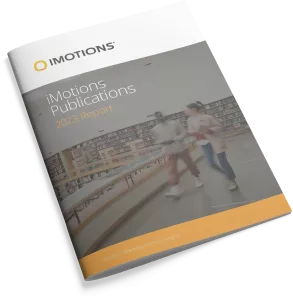-
EEG, Pupil Dilations, and Other Physiological Measures of Working Memory Load in the Sternberg Task
Recent evidence shows that physiological cues, such as pupil dilation (PD), heart rate (HR), skin conductivity (SC), and electroencephalography (EEG), can indicate cognitive load (CL) in users while performing tasks. This paper aims to investigate physiological (multimodal) measurement of CL in a Sternberg memory task as the difficulty level increases in both maintenance and probe […]
-
Investigating the impact of greenery elements in office environments on cognitive performance, visual attention and distraction: An eye-tracking pilot-study in virtual realityUnveiling impact dynamics: Discriminatory brand advertisements, stress response, and the call for ethical marketing practices
The human-nature connection is one of the main aspects determining supportive and comfortable office environments. In this context, the application of eye-tracking-equipped Virtual Reality (VR) devices to support an evaluation on the effect of greenery elements indoors on individuals’ efficiency and engagement is limited. A new approach to investigate visual attention, distraction, cognitive load and […]
-
Inclusive Design Insights from a Preliminary Image-Based Conversational Search Systems Evaluation
The digital realm has witnessed the rise of various search modalities, among which the Image-Based Conversational Search System stands out. This research delves into the design, implementation, and evaluation of this specific system, juxtaposing it against its text-based and mixed counterparts. A diverse participant cohort ensures a broad evaluation spectrum. Advanced tools facilitate emotion analysis, […]
-
Fixation-related potentials during mobile map assisted navigation in the real world: The effect of landmark visualization style
An often-proposed enhancement for mobile maps to aid assisted navigation is the presentation of landmark information, yet understanding of the manner in which they should be displayed is limited. In this study, we investigated whether the visualization of landmarks as 3D map symbols with either an abstract or realistic style influenced the subsequent processing of […]
-
Joy is reciprocally transmitted between teachers and students: Evidence on facial mimicry in the classroom
Background: The critical importance of positive emotions for classroom functioning is well established and teachers’ and learners’ trait-based joy during class has been shown to covary. This has been interpreted as evidence of emotional contagion across teachers and learners. However, no research to date seems to have explored in-situ processes of emotional contagion, thus the […]
-
Tracing emotional responses to nature-based tourism commercials and tagging individual sequences
Most tourism campaigns rely heavily on emotional appeals. Therefore, it is crucial to understand which video sequences elicit certain emotions to determine whether they are consistent with the targeted marketing objectives. In this study, we employ facial expression analysis to trace the emotional responses of participants watching a tourism destination commercial. Since previous studies did […]
-
More Than One Way: Fifth-Graders’ Varied Digital Reading Behaviors and Comprehension Outcomes
Digital reading is ubiquitous, yet understanding digital reading processes and links to comprehension remains underdeveloped. Guided by new literacies and active reading theories, this study explored the reading behaviors and comprehension of thirteen fifth graders who read static digital texts. We coded for the quantity and quality of digital reading behaviors and employed action path […]
-
A Comparative Study of Real and Virtual Environment via Psychological and Physiological Responses
Currently, immersive virtual environments (IVE) are widely used in fields such as architecture and environmental psychology. These simulated environments allow for a detailed evaluation of how different designs impact users’ perception and interaction with the built environment, under controlled conditions and without incurring high costs. The validity of these IVEs is related to their capacity […]
-
Evaluation of bicyclist physiological response and visual attention in commercial vehicle loading zones
Introduction With growing freight operations throughout the world, there is a push for transportation systems to accommodate trucks during loading and unloading operations. Currently, many urban locations do not provide loading and unloading zones, which results in trucks parking in places that obstruct bicyclist’s roadway infrastructure (e.g., bicycle lanes). Method To understand the implications of […]
-
Impact of Artificial Intelligence on Dentists’ Gaze during Caries Detection: A Randomized Controlled Trial
Objectives We aimed to understand how artificial intelligence (AI) influences dentists by comparing their gaze behavior when using versus not using an AI software to detect primary proximal carious lesions on bitewing radiographs. Methods 22 dentists assessed a median of 18 bitewing images resulting in 170 datasets from dentists without AI and 179 datasets from […]
Research Report 2023
In-depth look at the scientific landscape as powered by iMotions software, showcasing groundbreaking research and the impact of our tools in various scientific and industrial fields.

Share Your Research

850+ universities worldwide with an iMotions human behavior lab
73 of the top 100 highest ranked universities
710+ published research papers using iMotions
iMotions is used for some of the most interesting human behavior research studies carried out by top researchers around the world. Contact us to have your publication featured here.
The authors of these publications have used iMotions as a software tool within their research.
“Software should be cited on the same basis as any other research product such as a paper or a book; that is, authors should cite the appropriate set of software products just as they cite the appropriate set of papers” (Katz et al., 2020).
We therefore encourage you to cite the use of iMotions where appropriate.
How to cite iMotions
APA
iMotions (10), iMotions A/S, Copenhagen, Denmark, (2024).
Note: adjust the version and year where relevant.
5 Most Popular Blogs
Learn How to Conduct Human Behavior Research with iMotions
Publications
Read publications made possible with iMotions
Blog
Get inspired and learn more from our expert content writers
Newsletter
A monthly close up of latest product and research news





